Evaluation on the Restoration Effects in the River Restoration Projects Practiced in South Korea
Abstract
:1. Introduction
2. Study Areas
3. Materials and Methods
3.1. Evaluation of Naturalness
3.2. Vegetation Survey
3.3. Data Processing
3.4. Statistical Analysis
4. Results
4.1. Naturalness Degree Based on the Riverine Structure
4.2. Vegetation Profile
4.3. Species Composition
4.4. Species Richness
4.5. Exotic Plant Species
4.6. Naturalness Based on the Riparian Vegetation
5. Discussion
5.1. Evaluation of the River Restoration Carried out in South Korea
5.2. Recommendation for Improvement of Current River Restoration Project
6. Conclusions
Author Contributions
Funding
Conflicts of Interest
References
- Lee, C.S.; Cho, Y.C.; Shin, H.C.; Moon, J.S.; Lee, B.C.; Bae, Y.S.; Byun, H.G.; Yi, H.B. Ecological response of streams in Korea under different management regimes. Water Eng. Res. 2005, 6, 131–147. [Google Scholar]
- Lee, C.S.; Lee, H.; Kim, A.R.; Pi, J.H.; Bae, Y.J.; Choi, J.K.; Lee, W.S.; Moon, J.S. Ecological effects of daylighting and plant reintroduction to the Cheonggye Stream in Seoul, Korea. Ecol. Eng. 2020, 152, 105879. [Google Scholar] [CrossRef]
- Lim, C.H.; Pi, J.H.; Kim, A.R.; Cho, H.J.; Lee, K.S.; You, Y.H.; Lee, K.H.; Kim, K.D.; Moon, J.S.; Lee, C.S. Diagnostic Evaluation and Preparation of the Reference Information for River Restoration in South Korea. Int. J. Environ. Res. Public Health 2021, 18, 1724. [Google Scholar] [CrossRef] [PubMed]
- Bradshaw, A.D. Ecological principles and land reclamation practice. Landsc. Plan. 1984, 11, 35–48. [Google Scholar] [CrossRef]
- Society for Ecological Restoration International Science (SERI) and Policy Working Group (PWG). The SER International Primer on Ecological Restoration; Society for Ecological Restoration International: Tucson, AZ, USA, 2004. [Google Scholar]
- McDonald, T.; Gann, G.; Jonson, J.; Dixon, K. International Standards for the Practice of Ecological Restoration–Including Principles and Key Concepts; Society for Ecological Restoration: Washington, DC, USA, 2016. [Google Scholar]
- Ewel, J.J. Restoration Is the Ultimate Test of Ecological Theory; Cambridge University Press: Cambridge, UK, 1987; pp. 31–33. [Google Scholar]
- Bradshaw, A.D. The reclamation of derelict land and the ecology of ecosystems. In Restoration Ecology: A Synthetic Approach to Ecological Research; Jordan, W.R., Jordan, W.R., III, Gilpin, M.E., Aber, J.D., Eds.; Cambridge University Press: Cambridge, UK, 1987; pp. 53–74. [Google Scholar]
- Choi, Y.D. Theories for ecological restoration in changing environment: Toward ‘futuristic’restoration. Ecol. Res. 2004, 19, 75–81. [Google Scholar] [CrossRef]
- Lee, C.S.; Jeong, Y.M.; Kang, H.S. Concept, direction, and task of ecological restoration. J. Restor. Ecol. 2011, 2, 59–71. [Google Scholar]
- Kim, A.R.; Kim, D.U.; Lim, B.S.; Seol, J.; Lee, C.S. An evaluation on restoration effect in the restored Yangjae stream and the Improvement Plan Based on the result. Korean J. Ecol. Environ. 2020, 53, 390–407. [Google Scholar] [CrossRef]
- Seavy, N.E.; Gardali, T.; Golet, G.H.; Griggs, F.T.; Howell, C.A.; Kelsey, R.; Small, S.L.; Viers, J.H.; Weigand, J.F. Why climate change makes riparian restoration more important than ever: Recommendations for practice and research. Ecol. Restor. 2009, 27, 330–338. [Google Scholar] [CrossRef]
- Park, S.A.; Kim, G.S.; Pee, J.H.; Oh, W.S.; Kim, H.S.; Lee, C.S. Reference information for realizing ecological restoration of river: A case study in the Bongseonsa stream. J. Ecol. Environ. 2013, 36, 235–243. [Google Scholar] [CrossRef]
- Kim, A.R.; Lim, B.S.; Seol, J.; Lee, C.S. Principle of restoration ecology reflected in the process creating the National Institute of Ecology. J. Ecol. Environ. 2021, 45, 12. [Google Scholar] [CrossRef]
- Sigurdur, G. Restoration Ecology; Jones and Bartlett Learning: Sudbury, MA, USA, 2011. [Google Scholar]
- Kim, Y.H.; Ryoo, S.B.; Baik, J.J.; Park, I.S.; Koo, H.J.; Nam, J.C. Does the restoration of an inner-city stream in Seoul affect local thermal environment? Theor. Appl. Climatol. 2008, 92, 239–248. [Google Scholar] [CrossRef]
- Kondolf, G.M.; Anderson, S.; Lave, R.; Pagano, L.; Merenlender, A.; Bernhardt, E.S. Two Decades of River Restoration in California: What Can We Learn? Restor. Ecol. 2007, 15, 516–523. [Google Scholar] [CrossRef]
- Palmer, M.; Allan, J.D.; Meyer, J.; Bernhardt, E.S. River Restoration in the Twenty-First Century: Data and Experiential Knowledge to Inform Future Efforts. Restor. Ecol. 2007, 15, 472–481. [Google Scholar] [CrossRef]
- Tischew, S.; Baasch, A.; Conrad, M.K.; Kirmer, A. Evaluating Restoration Success of Frequently Implemented Compensation Measures: Results and Demands for Control Procedures. Restor. Ecol. 2010, 18, 467–480. [Google Scholar] [CrossRef]
- Nilsson, C.; Aradottir, A.L.; Hagen, D.; Halldórsson, G.; Høegh, K.; Mitchell, R.J.; Raulund-Rasmussen, K.; Svavarsdóttir, K.; Tolvanen, A.; Wilson, S.D. Evaluating the process of ecological restoration. Ecol. Soc. 2016, 21, 41. [Google Scholar] [CrossRef]
- Downs, P.W.; Kondolf, G.M. Post-Project Appraisals in Adaptive Management of River Channel Restoration. Environ. Manag. 2002, 29, 477–496. [Google Scholar] [CrossRef]
- Morandi, B.; Piégay, H.; Lamouroux, N.; Vaudor, L. How is success or failure in river restoration projects evaluated? Feedback from French restoration projects. J. Environ. Manag. 2014, 137, 178–188. [Google Scholar] [CrossRef]
- Wilson, K.A.; Lulow, M.; Burger, J.; Fang, Y.-C.; Andersen, C.; Olson, D.; O’Connell, M.; McBride, M.F. Optimal restoration: Accounting for space, time and uncertainty. J. Appl. Ecol. 2011, 48, 715–725. [Google Scholar] [CrossRef]
- Lindenmayer, D.B.; Likens, G.E.; Franklin, J.F. Rapid responses to facilitate ecological discoveries from major disturbances. Front. Ecol. Environ. 2010, 8, 527–532. [Google Scholar] [CrossRef]
- Palmer Margaret, A.; Filoso, S. Restoration of Ecosystem Services for Environmental Markets. Science 2009, 325, 575–576. [Google Scholar] [CrossRef]
- Gann, G.D.; McDonald, T.; Walder, B.; Aronson, J.; Nelson, C.R.; Jonson, J.; Hallett, J.G.; Eisenberg, C.; Guariguata, M.R.; Liu, J. International principles and standards for the practice of ecological restoration. Restor. Ecol. 2019, 27, S1–S46. [Google Scholar] [CrossRef]
- Xiang, H.; Wang, Z.; Mao, D.; Zhang, J.; Xi, Y.; Du, B.; Zhang, B. What did China’s National Wetland Conservation Program Achieve? Observations of changes in land cover and ecosystem services in the Sanjiang Plain. J. Environ. Manag. 2020, 267, 110623. [Google Scholar] [CrossRef] [PubMed]
- Hobbs, R.J.; Norton, D.A. Towards a Conceptual Framework for Restoration Ecology. Restor. Ecol. 1996, 4, 93–110. [Google Scholar] [CrossRef]
- Asbjornsen, H.; Brudvig, L.A.; Mabry, C.M.; Evans, C.W.; Karnitz, H.M. Defining reference information for restoring ecologically rare tallgrass oak savannas in the Midwestern United States. J. For. 2005, 103, 345–350. [Google Scholar]
- Thorpe, A.S.; Stanley, A.G. Determining appropriate goals for restoration of imperilled communities and species. J. Appl. Ecol. 2011, 48, 275–279. [Google Scholar] [CrossRef]
- Fulé, P.Z. Does It Make Sense to Restore Wildland Fire in Changing Climate? Restor. Ecol. 2008, 16, 526–531. [Google Scholar] [CrossRef]
- Seabrook, L.; McAlpine, C.A.; Bowen, M.E. Restore, repair or reinvent: Options for sustainable landscapes in a changing climate. Landsc. Urban Plan. 2011, 100, 407–410. [Google Scholar] [CrossRef]
- Hull, R.B.; Gobster, P.H. Restoring Forest Ecosystems: The Human Dimension. J. For. 2000, 98, 32–36. [Google Scholar] [CrossRef]
- Burke, S.M.; Mitchell, N. People as ecological participants in ecological restoration. Restor. Ecol. 2007, 15, 348–350. [Google Scholar] [CrossRef]
- Hobbs, R. Woodland restoration in Scotland: Ecology, history, culture, economics, politics and change. J. Environ. Manag. 2009, 90, 2857–2865. [Google Scholar] [CrossRef]
- Le, H.D.; Smith, C.; Herbohn, J.; Harrison, S. More than just trees: Assessing reforestation success in tropical developing countries. J. Rural Stud. 2012, 28, 5–19. [Google Scholar] [CrossRef]
- Wortley, L.; Hero, J.-M.; Howes, M. Evaluating Ecological Restoration Success: A Review of the Literature. Restor. Ecol. 2013, 21, 537–543. [Google Scholar] [CrossRef]
- Yang, Y.; Tilman, D.; Furey, G.; Lehman, C. Soil carbon sequestration accelerated by restoration of grassland biodiversity. Nat. Commun. 2019, 10, 718. [Google Scholar] [CrossRef] [PubMed] [Green Version]
- Wang, L.; Li, Z.; Wang, D.; Chen, J.; Liu, Y.; Nie, X.; Zhang, Y.; Ning, K.; Hu, X. Unbalanced social-ecological development within the Dongting Lake basin: Inspiration from evaluation of ecological restoration projects. J. Clean. Prod. 2021, 315, 128161. [Google Scholar] [CrossRef]
- Kerans, B.L.; Karr, J.R. A Benthic Index of Biotic Integrity (B-IBI) for Rivers of the Tennessee Valley. Ecol. Appl. 1994, 4, 768–785. [Google Scholar] [CrossRef]
- Ruiz-Jaen, M.C.; Mitchell Aide, T. Restoration Success: How Is It Being Measured? Restor. Ecol. 2005, 13, 569–577. [Google Scholar] [CrossRef]
- Bonada, N.; Prat, N.; Resh, V.H.; Statzner, B. Developments in aquatic insect biomonitoring: A comparative analysis of recent approaches. Annu. Rev. Entomol. 2006, 51, 495–523. [Google Scholar] [CrossRef]
- Resh, V.H. Which group is best? Attributes of different biological assemblages used in freshwater biomonitoring programs. Environ. Monit. Assess. 2008, 138, 131–138. [Google Scholar] [CrossRef]
- Miller, S.W.; Budy, P.; Schmidt, J.C. Quantifying Macroinvertebrate Responses to In-Stream Habitat Restoration: Applications of Meta-Analysis to River Restoration. Restor. Ecol. 2010, 18, 8–19. [Google Scholar] [CrossRef]
- Palmer, M.A.; Menninger, H.L.; Bernhardt, E. River restoration, habitat heterogeneity and biodiversity: A failure of theory or practice? Freshw. Biol. 2010, 55, 205–222. [Google Scholar] [CrossRef]
- Brudvig, L.A. The restoration of biodiversity: Where has research been and where does it need to go? Am. J. Bot. 2011, 98, 549–558. [Google Scholar] [CrossRef] [PubMed]
- Leps, M.; Sundermann, A.; Tonkin, J.D.; Lorenz, A.W.; Haase, P. Time is no healer: Increasing restoration age does not lead to improved benthic invertebrate communities in restored river reaches. Sci. Total Environ. 2016, 557–558, 722–732. [Google Scholar] [CrossRef] [PubMed]
- Rubin, Z.; Kondolf, G.M.; Rios-Touma, B. Evaluating Stream Restoration Projects: What Do We Learn from Monitoring? Water 2017, 9, 174. [Google Scholar] [CrossRef] [Green Version]
- Stoffers, T.; Collas, F.P.L.; Buijse, A.D.; Geerling, G.W.; Jans, L.H.; van Kessel, N.; Verreth, J.A.J.; Nagelkerke, L.A.J. 30 years of large river restoration: How long do restored floodplain channels remain suitable for targeted rheophilic fishes in the lower river Rhine? Sci. Total Environ. 2021, 755, 142931. [Google Scholar] [CrossRef] [PubMed]
- Zhang, P.; Li, K.; Liu, Q.; Liu, R.; Qin, L.; Wang, H.; Zhang, Z.; Wang, K.; Wang, Y.; Liang, R.; et al. Linking bait and feeding opportunities to fish foraging habitat for the assessment of environmental flows and river restoration. Sci. Total Environ. 2021, 768, 144580. [Google Scholar] [CrossRef] [PubMed]
- Kondolf, G.M.; Li, S. The pebble count technique for quantifying surface bed material size in instream flow studies. Rivers 1992, 3, 80–87. [Google Scholar]
- Kondolf, G.M. Application of the pebble count: Notes on purpose, method, and variants. JAWRA J. Am. Water Resour. Assoc. 1997, 33, 79–87. [Google Scholar] [CrossRef]
- Barbour, M.T. Rapid Bioassessment Protocols for Use in Wadeable Streams and Rivers: Periphyton, Benthic Macroinvertebrates and Fish; US Environmental Protection Agency, Office of Water: Washington, DC, USA, 1999.
- Rosgen, D.L. A practical method of computing streambank erosion rate. In Proceedings of the Seventh Federal Interagency Sedimentation Conference, Reno, NV, USA, 25–29 March 2001. [Google Scholar]
- Gardali, T.; Holmes, A.L.; Small, S.L.; Nur, N.; Geupel, G.R.; Golet, G.H. Abundance Patterns of Landbirds in Restored and Remnant Riparian Forests on the Sacramento River, California, U.S.A. Restor. Ecol. 2006, 14, 391–403. [Google Scholar] [CrossRef]
- Ohio Environmental Protection Agency. Division of Surface Water Methods for Assessing Habitat in Flowing Waters: Using the Qualitative Habitat Evaluation Index (QHEI); Ohio Environmental Protection Agency: Columbus, OH, USA, 2006. [Google Scholar]
- Whitacre, H.W.; Roper, B.B.; Kershner, J.L. A Comparison of Protocols and Observer Precision for Measuring Physical Stream Attributes1. JAWRA J. Am. Water Resour. Assoc. 2007, 43, 923–937. [Google Scholar] [CrossRef]
- Florsheim, J.L.; Mount, J.F.; Chin, A. Bank Erosion as a Desirable Attribute of Rivers. BioScience 2008, 58, 519–529. [Google Scholar] [CrossRef]
- Shields, F.D.; Lizotte, R.E.; Knight, S.S.; Cooper, C.M.; Wilcox, D. The stream channel incision syndrome and water quality. Ecol. Eng. 2010, 36, 78–90. [Google Scholar] [CrossRef]
- Bennett, S.J.; Simon, A.; Castro, J.M.; Atkinson, J.F.; Bronner, C.E.; Blersch, S.S.; Rabideau, A.J. The evolving science of stream restoration. In Stream Restoration in Dynamic Fluvial Systems; Simon, A., Bennett, S.J., Castro, J.M., Eds.; American Geophysical Union: Washington, DC, USA, 2011; Volume 194, pp. 1–8. [Google Scholar]
- Golet, G.H.; Brown, D.L.; Carlson, M.; Gardali, T.; Henderson, A.; Holl, K.D.; Howell, C.A.; Holyoak, M.; Hunt, J.W.; Kondolf, G.M. Successes, failures and suggested future directions for ecosystem restoration of the middle Sacramento River, California. San Fr. Estuary Watershed Sci. 2013, 11. [Google Scholar] [CrossRef]
- Lisle, T.E.; Buffington, J.M.; Wilcock, P.R.; Bunte, K. Can Rapid Assessment Protocols Be Used to Judge Sediment Impairment in Gravel-Bed Streams? A Commentary. JAWRA J. Am. Water Resour. Assoc. 2015, 51, 373–387. [Google Scholar] [CrossRef]
- Wild, T.C.; Bernet, J.F.; Westling, E.L.; Lerner, D.N. Deculverting: Reviewing the evidence on the ‘daylighting’ and restoration of culverted rivers. Water Environ. J. 2011, 25, 412–421. [Google Scholar] [CrossRef]
- Zingraff-Hamed, A.; Noack, M.; Greulich, S.; Schwarzwälder, K.; Pauleit, S.; Wantzen, K.M. Model-Based Evaluation of the Effects of River Discharge Modulations on Physical Fish Habitat Quality. Water 2018, 10, 374. [Google Scholar] [CrossRef]
- Boromisza, Z.; Gergely, A.; Jákli, E.; Xuecheng, C. Landscape, ecological and visual impacts of a stream restoration in Hungary. In Proceedings of the Fábos Conference on Landscape and Greenway Planning, Amherst, MA, USA, 28–30 March 2019; pp. 1–4. [Google Scholar]
- Palmer, M.A.; Bernhardt, E.S.; Allan, J.D.; Lake, P.S.; Alexander, G.; Brooks, S.; Carr, J.; Clayton, S.; Dahm, C.N.; Follstad Shah, J.; et al. Standards for ecologically successful river restoration. J. Appl. Ecol. 2005, 42, 208–217. [Google Scholar] [CrossRef]
- Whittier, T.R.; Stoddard, J.L.; Larsen, D.P.; Herlihy, A.T. Selecting reference sites for stream biological assessments: Best professional judgment or objective criteria. J. N. Am. Benthol. Soc. 2007, 26, 349–360. [Google Scholar]
- Woolsey, S.; Capelli, F.; Gonser, T.O.M.; Hoehn, E.; Hostmann, M.; Junker, B.; Paetzold, A.; Roulier, C.; Schweizer, S.; Tiegs, S.D.; et al. A strategy to assess river restoration success. Freshw. Biol. 2007, 52, 752–769. [Google Scholar] [CrossRef]
- Gilvear, D.; Bryant, R. Analysis of remotely sensed data for fluvial geomorphology and river science. In Tools in Fluvial Geomorphology; John Wiley and Sons: Chichester, UK, 2016; pp. 103–132. [Google Scholar]
- Ministry of Environment. River Restoration Model and Criteria to Recover Health of the Aquatic Ecosystem; Ministry of Environment: Sejong, Korea, 2007. [Google Scholar]
- Kuechler, A.W.; Zonneveld, I.S. Vegetation Mapping; Kluwer Academic Publications: Boston, MA, USA, 1988. [Google Scholar]
- Ellenberg, D.; Mueller-Dombois, D. Aims and Methods of Vegetation Ecology; Wiley: New York, NY, USA, 1974. [Google Scholar]
- Braun-Blanquet, J. Pflanzensoziologie: Grundzüge der Vegetationskunde; Springer: Berlin/Heidelberg, Germany, 1964. [Google Scholar]
- Lee, T.B. Illustrated Flora of Korea; HyangMoonSa: Seoul, Korea, 1985. [Google Scholar]
- Korea National Arboretum. Korean Plant Names Index. Available online: http://www.nature.go.kr/kbi/plant/pilbk/selectPlantPilbkGnrlList.do (accessed on 10 July 2022).
- Curtis, J.T.; McIntosh, R.P. An Upland Forest Continuum in the Prairie-Forest Border Region of Wisconsin. Ecology 1951, 32, 476–496. [Google Scholar] [CrossRef]
- Hill, M.O.; Gauch, H.G. Detrended Correspondence Analysis: An Improved Ordination Technique. In Classification and Ordination: Symposium on Advances in Vegetation Science, Nijmegen, The Netherlands, May 1979; van der Maarel, E., Ed.; Springer: Dordrecht, The Netherlands, 1980; pp. 47–58. [Google Scholar]
- Lee, C.S.; You, Y.H. Creation of an environmental forest as an ecological restoration. Korean J. Ecol. 2001, 24, 101–109. [Google Scholar]
- Magurran, A.E. Ecological Diversity and Its Measurement; Princeton University Press: Princeton, NJ, USA, 1988. [Google Scholar]
- Kent, M. Vegetation Description and Data Analysis: A Practical Approach; John Wiley & Sons: Hoboken, FL, USA, 2011. [Google Scholar]
- Lake, P.S.; Bond, N.; Reich, P. Linking ecological theory with stream restoration. Freshw. Biol. 2007, 52, 597–615. [Google Scholar] [CrossRef]
- Hobbs, R.J.; Cramer, V.A. Restoration Ecology: Interventionist Approaches for Restoring and Maintaining Ecosystem Function in the Face of Rapid Environmental Change. Annu. Rev. Environ. Resour. 2008, 33, 39–61. [Google Scholar] [CrossRef]
- Aronson, J.; Floret, C.; Le Floc’h, E.; Ovalle, C.; Pontanier, R. Restoration and Rehabilitation of Degraded Ecosystems in Arid and Semi-Arid Lands. I. A View from the South. Restor. Ecol. 1993, 1, 8–17. [Google Scholar] [CrossRef]
- Lüderitz, V.; Jüpner, R.; Müller, S.; Feld, C.K. Renaturalization of streams and rivers—The special importance of integrated ecological methods in measurement of success. An example from Saxony-Anhalt (Germany). Limnologica 2004, 34, 249–263. [Google Scholar] [CrossRef]
- Lee, C.S.; Cho, Y.C.; Lee, A.N. Restoration Planning for the Seoul Metropolitan Area, Korea. In Ecology, Planning, and Management of Urban Forests: International Perspectives; Carreiro, M.M., Song, Y.-C., Wu, J., Eds.; Springer: New York, NY, USA, 2008; pp. 393–419. [Google Scholar]
- Karr, J.R. Ecological Integrity and Ecological Health Are Not the Same; National Academy Press: Washington, DC, USA, 1996. [Google Scholar]
- White, P.S.; Walker, J.L. Approximating Nature’s Variation: Selecting and Using Reference Information in Restoration Ecology. Restor. Ecol. 1997, 5, 338–349. [Google Scholar] [CrossRef]
- Rood, S.B.; Gourley, C.R.; Ammon, E.M.; Heki, L.G.; Klotz, J.R.; Morrison, M.L.; Mosley, D.; Scoppettone, G.G.; Swanson, S.; Wagner, P.L. Flows for Floodplain Forests: A Successful Riparian Restoration. BioScience 2003, 53, 647–656. [Google Scholar]
- Palmer, M.A.; Hondula, K.L.; Koch, B.J. Ecological restoration of streams and rivers: Shifting strategies and shifting goals. Annu. Rev. Ecol. Evol. Syst. 2014, 45, 247–269. [Google Scholar] [CrossRef] [Green Version]
- An, J.H.; Lim, C.H.; Lim, Y.K.; Nam, K.B.; Lee, C.S. A review of restoration project evaluation and post management for ecological restoration of the river. J. Restor. Ecol. 2014, 4, 15–34. [Google Scholar]
- Fokkens, B. The Dutch strategy for safety and river flood prevention. In Extreme Hydrological Events: New Concepts for Security; Springer: Dordrecht, The Netherlands, 2007; pp. 337–352. [Google Scholar]
- An, J.H.; Lim, C.H.; Lim, Y.K.; Nam, K.B.; Pi, J.H.; Moon, J.S.; Bang, J.Y.; Lee, C.S. Diagnosis on the riparian vegetation in the downstream reach of the Gyungan Stream for creating vegetation belt. J. Korean Soc. Water Environ. 2015, 31, 680–692. [Google Scholar] [CrossRef]
- An, J.H.; Lim, C.H.; Jung, S.H.; Kim, A.R.; Woo, D.M.; Lee, C.S. Diagnostic evaluation on the riparian vegetation in the Changwon and nam streams for preparing a restoration plan. J. Korean Soc. Water Environ. 2016, 32, 475–491. [Google Scholar] [CrossRef]
- An, J.H.; Lim, C.H.; Lim, Y.K.; Nam, K.B.; Pi, J.H.; Moon, J.S.; Bang, J.Y.; Lee, C.S. Development and application of a model for restoring a vegetation belt to buffer pollutant discharge. J. Korean Soc. Water Environ. 2016, 32, 205–215. [Google Scholar] [CrossRef]
- An, J.H.; Lim, C.H.; Jung, S.H.; Kim, A.R.; Woo, D.M.; Lee, C.S. Restoration plan of Changwon and Nam streams based on the results of diagnostic assessment. J. Korean Soc. Water Environ. 2017, 33, 511–524. [Google Scholar]
- Jung, S.H.; Kim, A.R.; Seol, J.; Lim, B.S.; Lee, C.S. Characteristics and reference information of riparian vegetation for realizing ecological restoration classified by reach of the river in Korea. Korean Soc. Water Environ. 2018, 34, 447–461. [Google Scholar] [CrossRef]
- Reif, A. Confusion of Terms in South Korea: How Does the “Four Main Rivers Restoration Project” Affect Riparian Landscapes? Krit. Ökologie Nr. 2010, 25, 26–32. [Google Scholar]
- Lee, C.S. Role and task of restoration ecology in changing environment. Natl. Acad. Sci. 2016, 5, 481–527. [Google Scholar]
- van Rensburg, D. River Index of Habitat Integrity (IHI) and Riparian Vegetation Assessment for the Proposed Establishment of a Measuring Weir within the Caledon (Mohokare) River (Quaternary Drainage Region: D22D). Available online: https://sahris.sahra.org.za/sites/default/files/additionaldocs/Caledon%20IHI.pdf (accessed on 10 July 2022).
- Goodwin, C.N.; Hawkins, C.P.; Kershner, J.L. Riparian Restoration in the Western United States: Oveview and Perspecive. Restor. Ecol. 1997, 5, 4–14. [Google Scholar] [CrossRef]
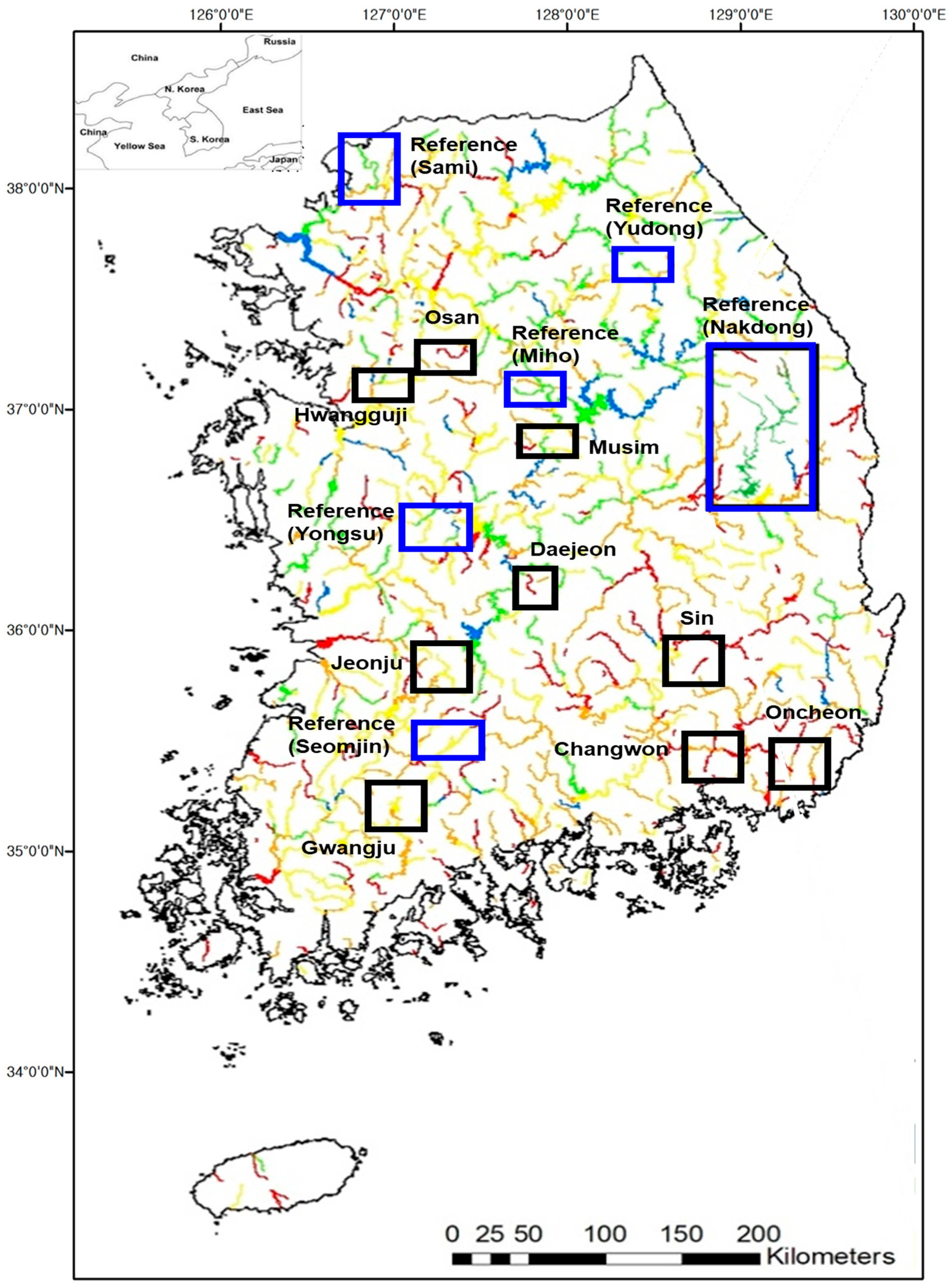

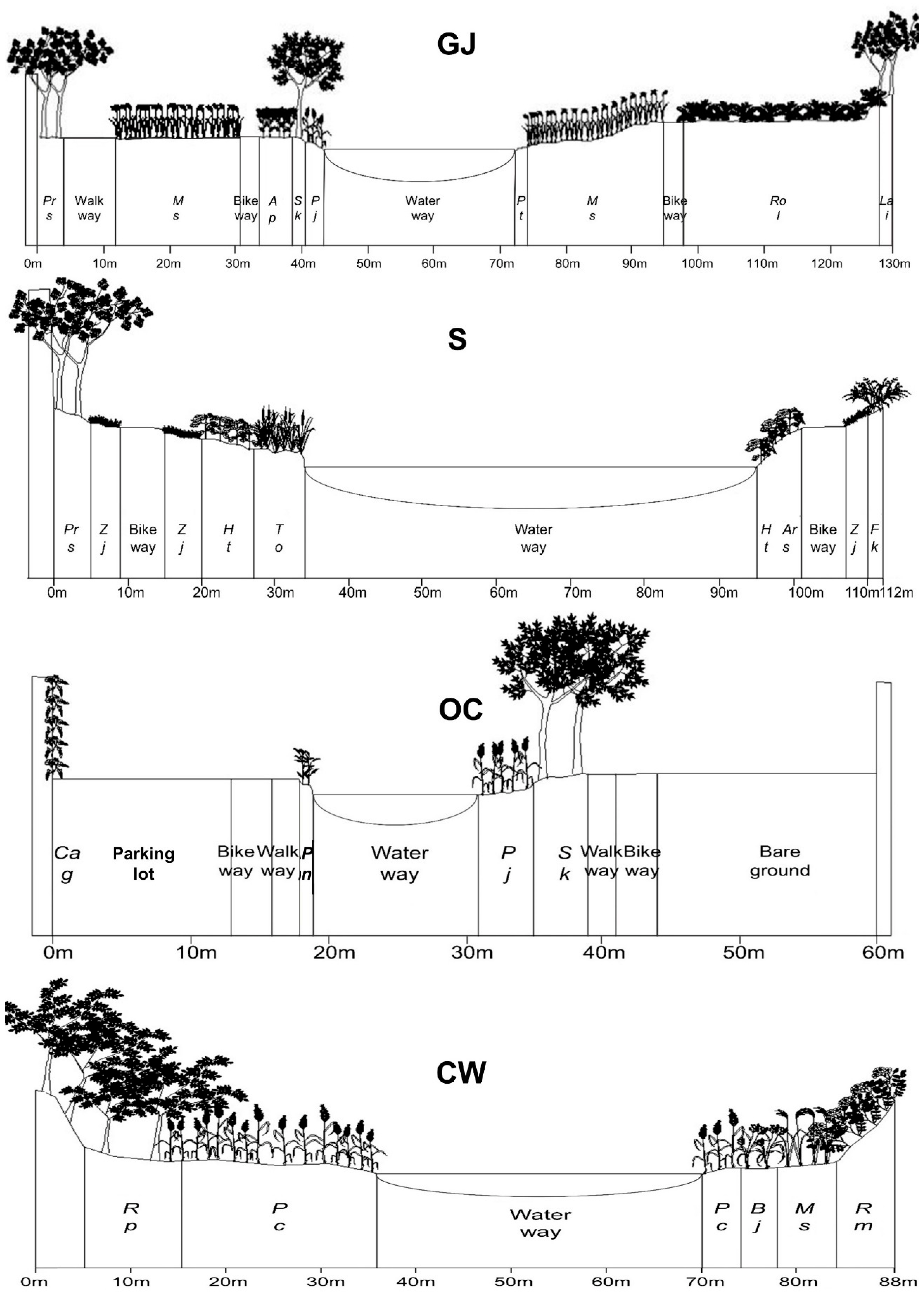
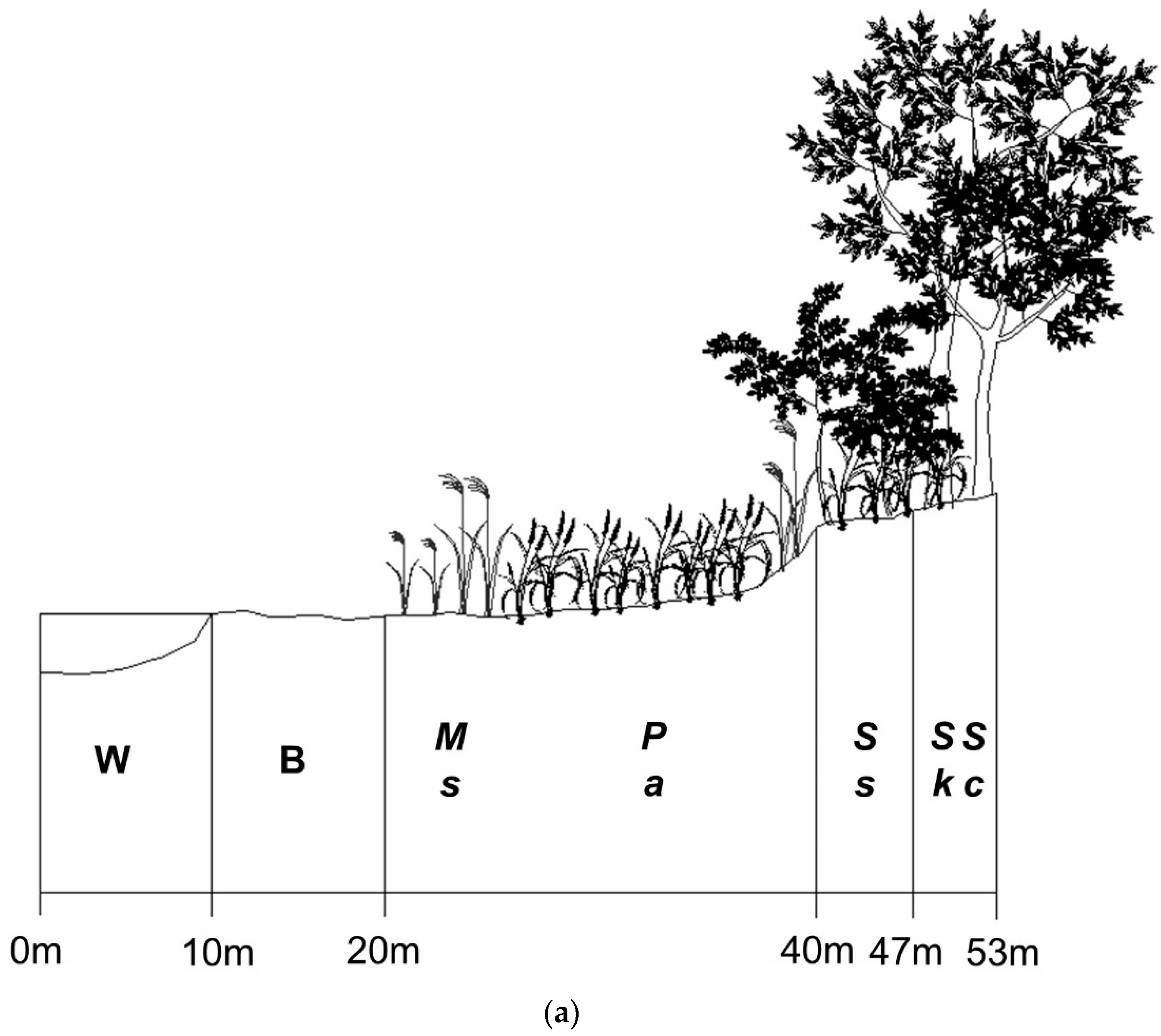

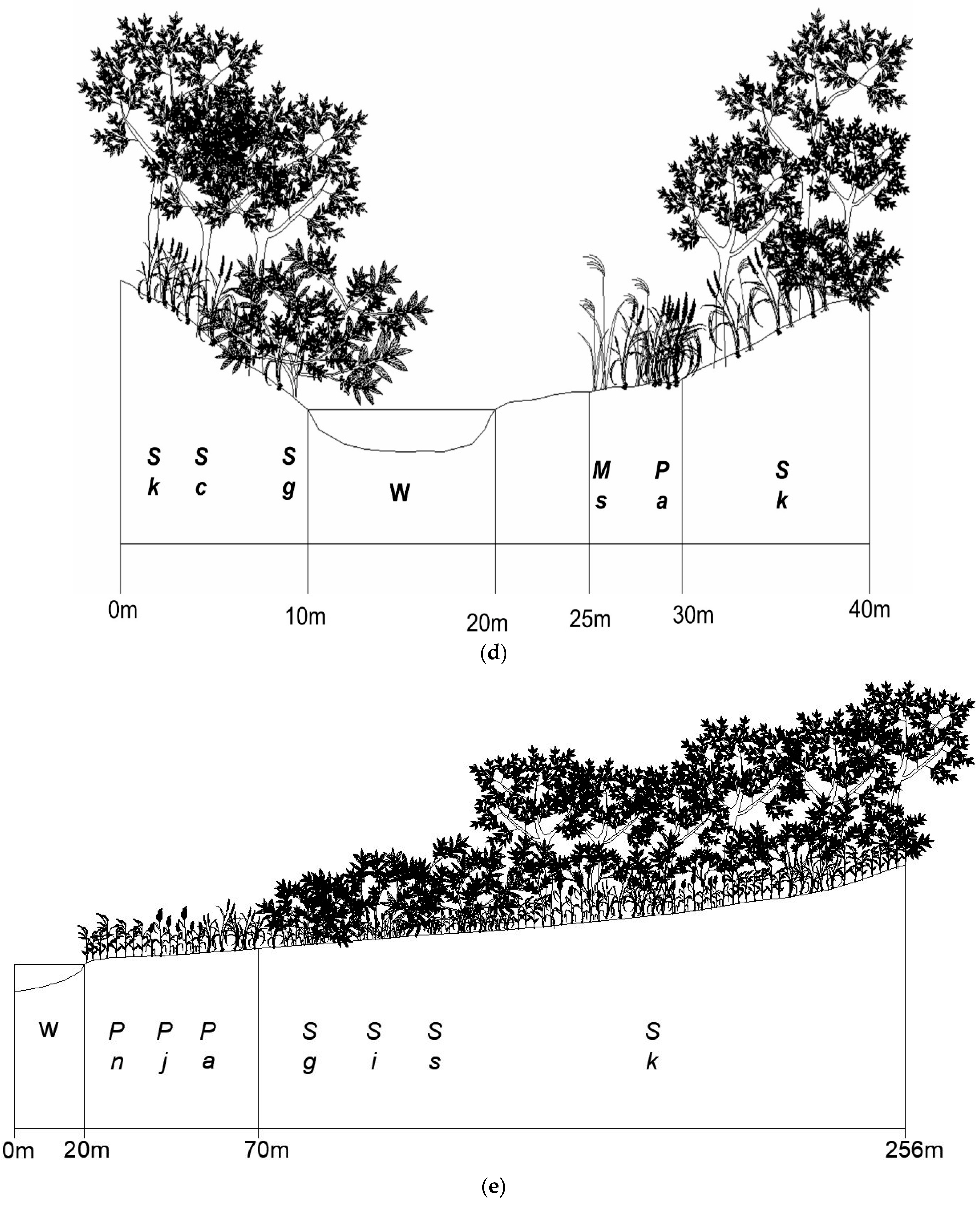
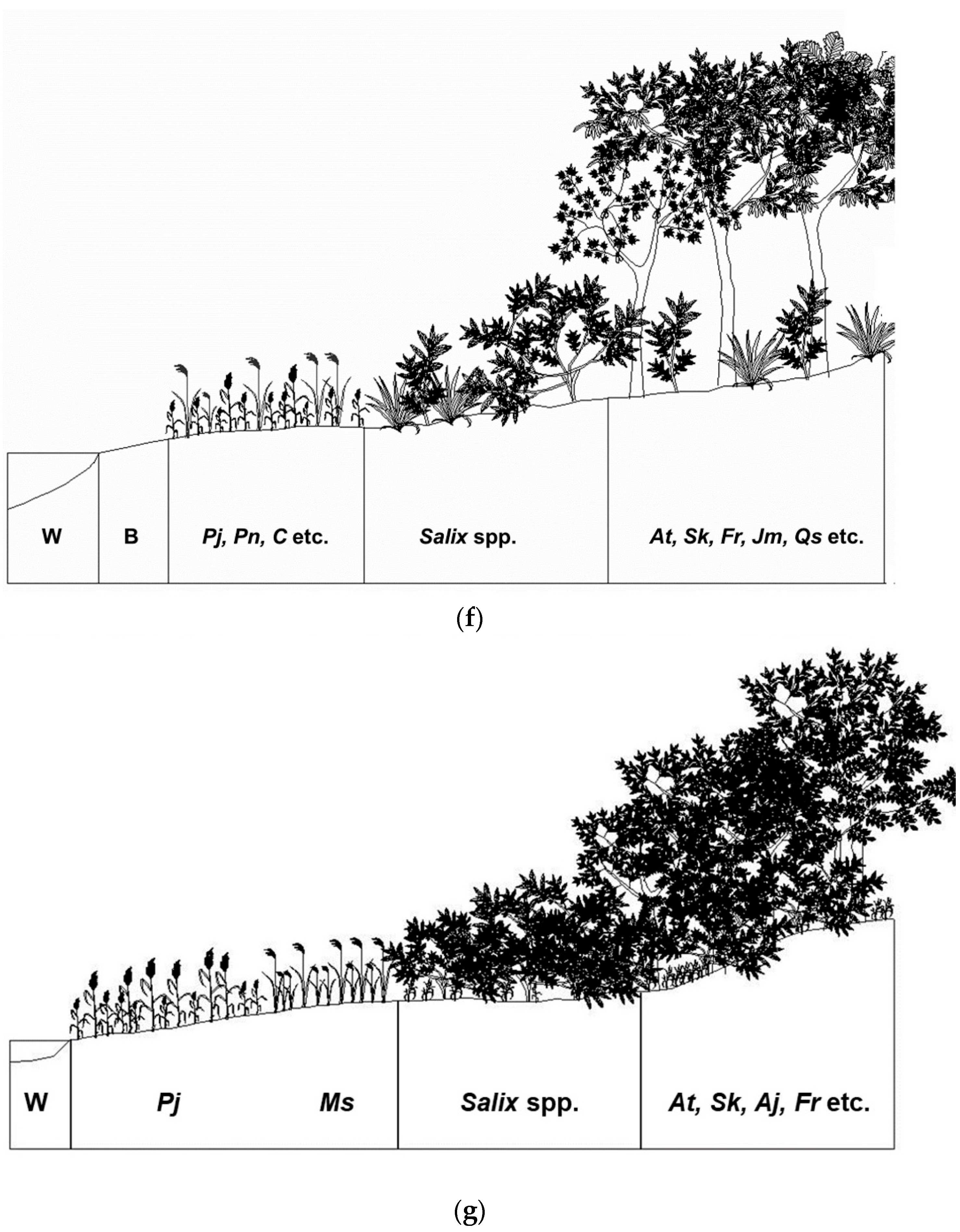


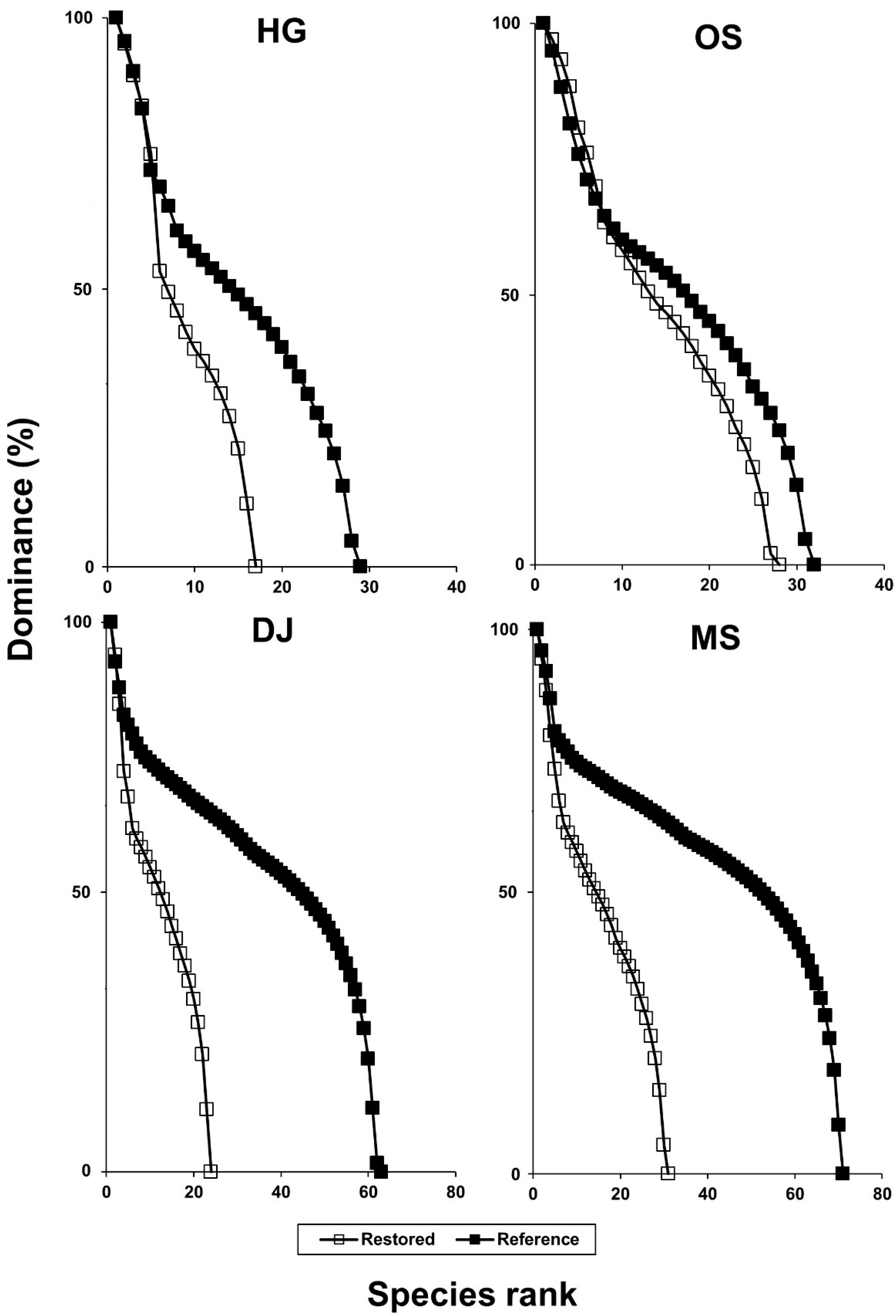



| Item | HG | OS | MS | DJ | JJ1 | JJ2 | GJ | S | OC | CW | Ref |
|---|---|---|---|---|---|---|---|---|---|---|---|
| Sinuosity of watercourse | 1 | 1 | 1 | 1 | 1 | 1 | 1 | 1 | 1 | 1 | 5 |
| The number of sandbars | 1 | 1 | 1 | 1 | 1 | 1 | 1 | 1 | 1 | 1 | 5 |
| Diversity of flow | 1 | 1 | 2 | 2 | 1 | 1 | 1 | 1 | 1 | 1 | 5 |
| River profile | 2 | 2 | 2 | 2 | 2 | 2 | 1 | 1 | 1 | 1 | 4 |
| Diversity of water course breadth | 1 | 1 | 2 | 2 | 1 | 2 | 1 | 1 | 1 | 1 | 4 |
| Degree of waterfront protection | 1 | 1 | 1 | 1 | 1 | 1 | 1 | 1 | 1 | 1 | 4 |
| Artificial degree of bank | 2 | 2 | 1 | 1 | 2 | 2 | 1 | 2 | 1 | 2 | 4 |
| Land use within bank | 2 | 2 | 2 | 1 | 2 | 2 | 1 | 1 | 1 | 2 | 5 |
| Floodplain use | 2 | 2 | 2 | 2 | 2 | 2 | 1 | 2 | 1 | 2 | 4 |
| Transverse artificial facilities | 2 | 2 | 2 | 2 | 1 | 2 | 2 | 2 | 1 | 2 | 4 |
| Study Site | SR(2) | EP(2) | OU(2) | AP(2) | CD(4) | VP(8) | RVI |
|---|---|---|---|---|---|---|---|
| HG | 3 | 5 | 4 | 2 | 2 | 3 | 60 |
| OS | 5 | 4 | 5 | 5 | 2 | 3 | 70 |
| MS | 3 | 3 | 4 | 4 | 4 | 3 | 68 |
| DJ | 3 | 2 | 3 | 3 | 2 | 3 | 54 |
| JJ | 1 | 5 | 2 | 3 | 4 | 3 | 62 |
| GJ | 2 | 4 | 4 | 1 | 3 | 3 | 58 |
| S | 2 | 1 | 2 | 3 | 2 | 1 | 30 |
| OC | 2 | 3 | 3 | 4 | 2 | 3 | 56 |
| CW | 2 | 4 | 2 | 5 | 3 | 2 | 54 |
| Ref (SM) | 5 | 3 | 4 | 3 | 5 | 5 | 90 |
| Ref (YD) | 5 | 4 | 5 | 2 | 4 | 5 | 88 |
| Ref (YS) | 5 | 4 | 2 | 5 | 4 | 5 | 86 |
| Ref (MH) | 5 | 3 | 3 | 5 | 4 | 5 | 88 |
| Ref (G) | 5 | 3 | 5 | 3 | 4 | 5 | 82 |
| Ref (SJ) | 4 | 3 | 5 | 5 | 4 | 5 | 87 |
| Ref (ND) | 5 | 5 | 4 | 4 | 4 | 5 | 92 |
Publisher’s Note: MDPI stays neutral with regard to jurisdictional claims in published maps and institutional affiliations. |
© 2022 by the authors. Licensee MDPI, Basel, Switzerland. This article is an open access article distributed under the terms and conditions of the Creative Commons Attribution (CC BY) license (https://creativecommons.org/licenses/by/4.0/).
Share and Cite
An, J.H.; Lim, B.S.; Seol, J.; Kim, A.R.; Lim, C.H.; Moon, J.S.; Lee, C.S. Evaluation on the Restoration Effects in the River Restoration Projects Practiced in South Korea. Water 2022, 14, 2739. https://doi.org/10.3390/w14172739
An JH, Lim BS, Seol J, Kim AR, Lim CH, Moon JS, Lee CS. Evaluation on the Restoration Effects in the River Restoration Projects Practiced in South Korea. Water. 2022; 14(17):2739. https://doi.org/10.3390/w14172739
Chicago/Turabian StyleAn, Ji Hong, Bong Soon Lim, Jaewon Seol, A Reum Kim, Chi Hong Lim, Jeong Sook Moon, and Chang Seok Lee. 2022. "Evaluation on the Restoration Effects in the River Restoration Projects Practiced in South Korea" Water 14, no. 17: 2739. https://doi.org/10.3390/w14172739





